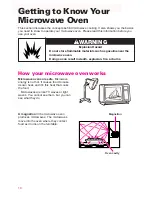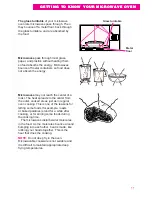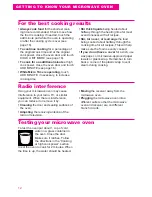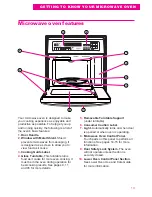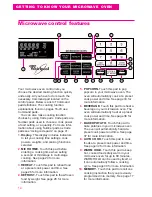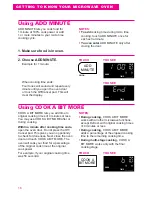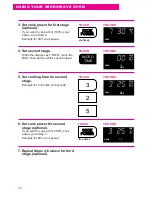
21
Cooking at different cook powers
For best results, some recipes call for
different cook powers. The lower the cook
power, the slower the cooking. Each
Number pad also stands for a different
percentage of cook power. Many micro-
wave cookbook recipes tell you by number,
percent, or name which cook power to use.
WHEN TO USE IT
•
Quick heating many convenience foods
and foods with high water content, such as
soups and beverages
•
Cooking small tender pieces of meat,
ground meat, poultry pieces, fish fillets,
and vegetables
•
Heating cream soups
•
Heating rice, pasta, or casseroles
•
Cooking and heating foods that need a
cook power lower than high (for example,
whole fish and meat loaf) or when food is
cooking too fast
•
Reheating a single serving of food
•
Cooking requiring special care, such as
cheese and egg dishes, pudding, and
custards
•
Finishing cooking casseroles
•
Cooking ham, whole poultry, and pot roasts
•
Melting chocolate
•
Simmering stews
•
Heating pastries
•
Defrosting foods, such as bread, fish,
meats, poultry, and precooked foods
•
Softening butter, cheese, and ice cream
•
Keeping food warm
•
Taking chill out of fruit
COOK POWER
10=100% of full power
9=90% of full power
8=80% of full power
7=70% of full power
6=60% of full power
5=50% of full power
4=40% of full power
3=30% of full power
2=20% of full power
1=10% of full power
NAME
High
Medium-High
Medium
Medium-Low,
Defrost
Low
The following chart gives the percentage
of cook power each Number pad stands for,
and the cook power name usually used. It
also tells you when to use each cook power.
Follow recipe or food package instructions
if available.
U S I N G Y O U R M I C R O W A V E O V E N
NOTE:
For additional cooking and reheating information, see “Micro time chart” on page 46.
Содержание RMC275PD
Страница 54: ...54 NOTES ...




